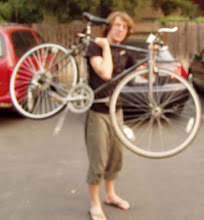Dana Point is a coastal town in Southern California, located almost exactly halfway between Los Angeles and San Diego. Dana Point sits at the southern tip of the greater LA/Orange County metro area along with neighboring San Clemente. To the south of these two beach cities lies a wilderness area dominated by Camp Pendleton. Dana Point gets its name from a mention in Richard Henry Dana's Two Years Before the Mast, where he described throwing cowhides off the bluffs of a cove that served as port for Mission San Juan Capistrano.
 Dad, Donna and Bri in the foreground, Dana Point bluffs and harbor in the midground and Catalina Island in the background, January
Dad, Donna and Bri in the foreground, Dana Point bluffs and harbor in the midground and Catalina Island in the background, JanuarySan Clemente brags that it has the best climate in the world. Both cities have an average 342 days of sunshine and typical highs in the high seventies/low eighties in the summer and low sixties in winter, respectively. Like all of California, the bulk of annual precipitation falls in winter months. However, among the cloudiest months is June, a phenomenon known locally as "June Gloom" and caused by warming ocean temperatures.
Trees commonly planted in Dana Point include palms, eucalyptus and coastal pines. Subtropical and Mediterranean plants are easily grown. Some classic continental plants that require chill or extreme heat are difficult to grow, like cherries and watermelons (though that didn't stop me from growing a 94lb pumpkin). Undeveloped headlands and canyons are mostly coastal sage scrub, a chaparral-type mixture of californian sage, sagebrush, lemonade berry and coyote broom.
Demographics in Dana Point are mixed, not possessing the wealth of northern neighbor Laguna Beach. A significant number of Mexican immigrants and lower-middle class whites live in apartments, while professional class people commute to central Orange County and live in hillside houses with ocean views. The local economy is driven primarily by tourism and the aforementioned commuters. The worst traffic jams in our area happen on sunny Saturday afternoons.
Many neighborhoods in Dana Point were developed slowly enough to evidence an eclectic mix of social classes. The oldest houses are beach cottages, built in the 50's with low square-footage and flat roofs. Many of Dana Point's N-S streets are named various colors of lanterns (ie Blue Lantern, Golden Lantern, Amber Lantern). The town's decor is mariner themed, and houses are frequently painted marine blue-grey. The town has approximately reached build-out, though adjacent landlocked cities demonstrate textbook McMansion sprawl, particularly Laguna Niguel, a place that handily manages to be both much wealthier and much uglier than Dana Point (I have a lot of high school friends from Niguel and that is fact, not opinion).
The local public education system is excellent. Dana Hills High is both a Blue Ribbon and California Distinguished School. It offers a large number of Advanced Placement courses and produces high standardized test scores. The school football team has always sucked. The school surf team is pretty good, but never beats neighboring rivals San Clemente, who frequently contend for the State Championship title.
 Prom photo, taken at one of the half dozen locations commonly used for weddings within walking distance of my house, May
Prom photo, taken at one of the half dozen locations commonly used for weddings within walking distance of my house, MayThe two cities collectively lay claim to a handful of excellent surf beaches that host annual surf contests including Salt Creek, Doheny, T-Street, Trestles and San Onofre. Dana Cove was famous for a surf break called Killer Dana until the harbor was built. Surf culture is everywhere, most visible in the many local board shops, board-laden cars and the popularity of the word "surf" in mostly taqueria restaurant names (one Dana Point restaurant, in fact, succinctly named "Taco Surf"). In addition to both Mexican-owned and white-owned taquerias, the region has a lot of local burger joints that recall the glory days of Southern California car culture, as well as a mix of 20$ entrée restaurants with an emphasis on California cuisine and sushi.
The overall culture is laid back. Politics are mildly conservative. In spite of those politics, hostility towards immigrants is remarkably low. Upper-middle class people either appreciate the Mexican immigrant population for services rendered (though I don't know anyone with an in-house maid, as pop culture might have you believe of OC, even in Laguna) or respect them for their strong work ethic. The stereotype of the lazy Mexican has always struck me as a foreign idea, product of Los Angeles demographics.
The overall culture is laid back. Politics are mildly conservative. In spite of those politics, hostility towards immigrants is remarkably low. Upper-middle class people either appreciate the Mexican immigrant population for services rendered (though I don't know anyone with an in-house maid, as pop culture might have you believe of OC, even in Laguna) or respect them for their strong work ethic. The stereotype of the lazy Mexican has always struck me as a foreign idea, product of Los Angeles demographics.
I live in a beach cottage in a mixed-income part of town. The yard is fronted by a couple of Canary Island Date Palms. It takes me 20 minutes to walk to Doheny with my surfboard underarm. I love the diversity of houses here. I love the weather, especially the foggy and cloudy days. I love the smell of sagebrush. I love getting burritos after a day at the beach with friends. I love walking downtown to pick up avocados from little Mexican markets. I love that my prom photos have a backdrop most wedding photos would be in envy of (in fact, Brandon's cousin flew from the east coast to get married in Dana Point this weekend). I love hearing Bandas on the neighbor's radios. I love Dana Point.



No comments:
Post a Comment